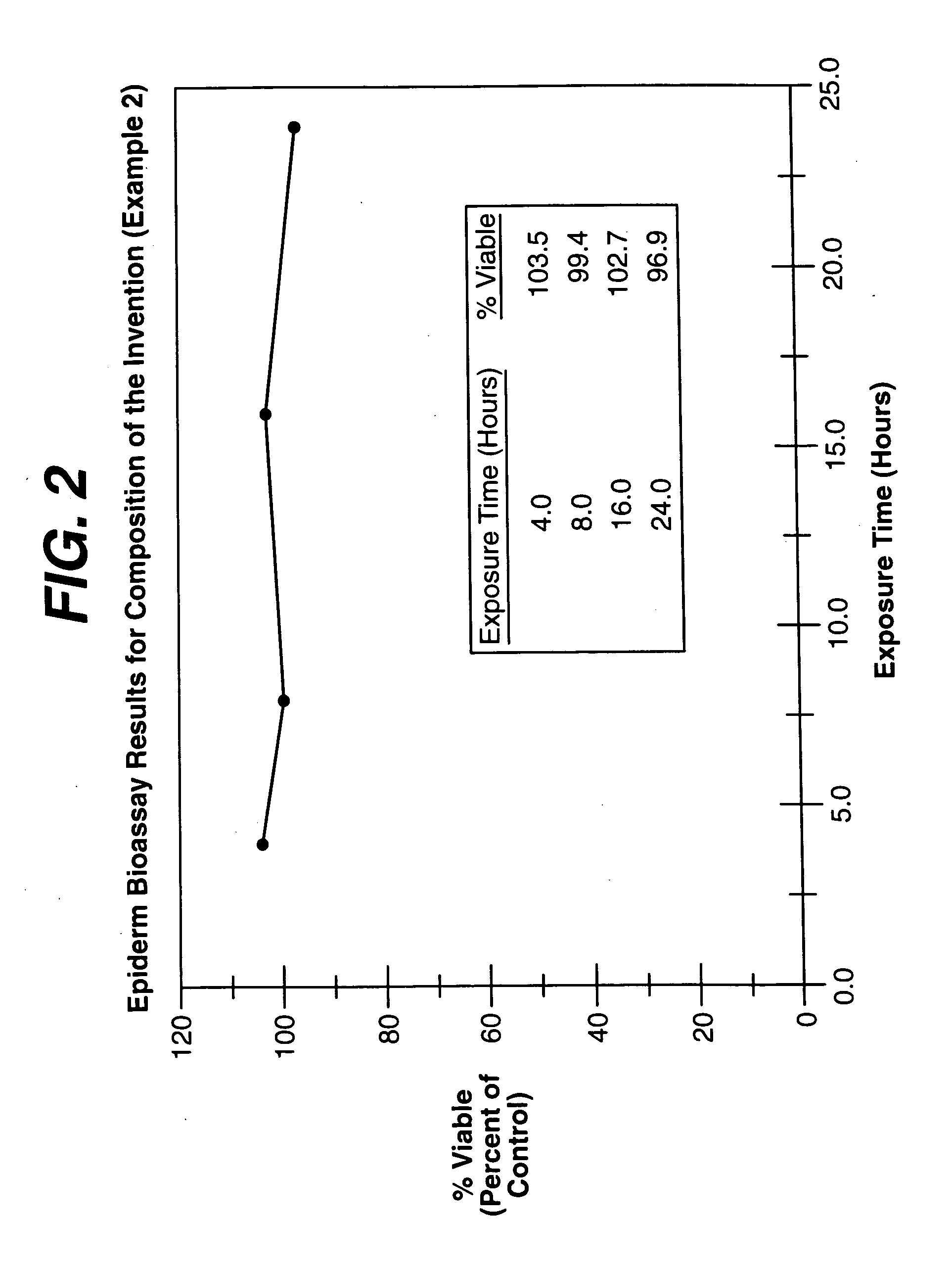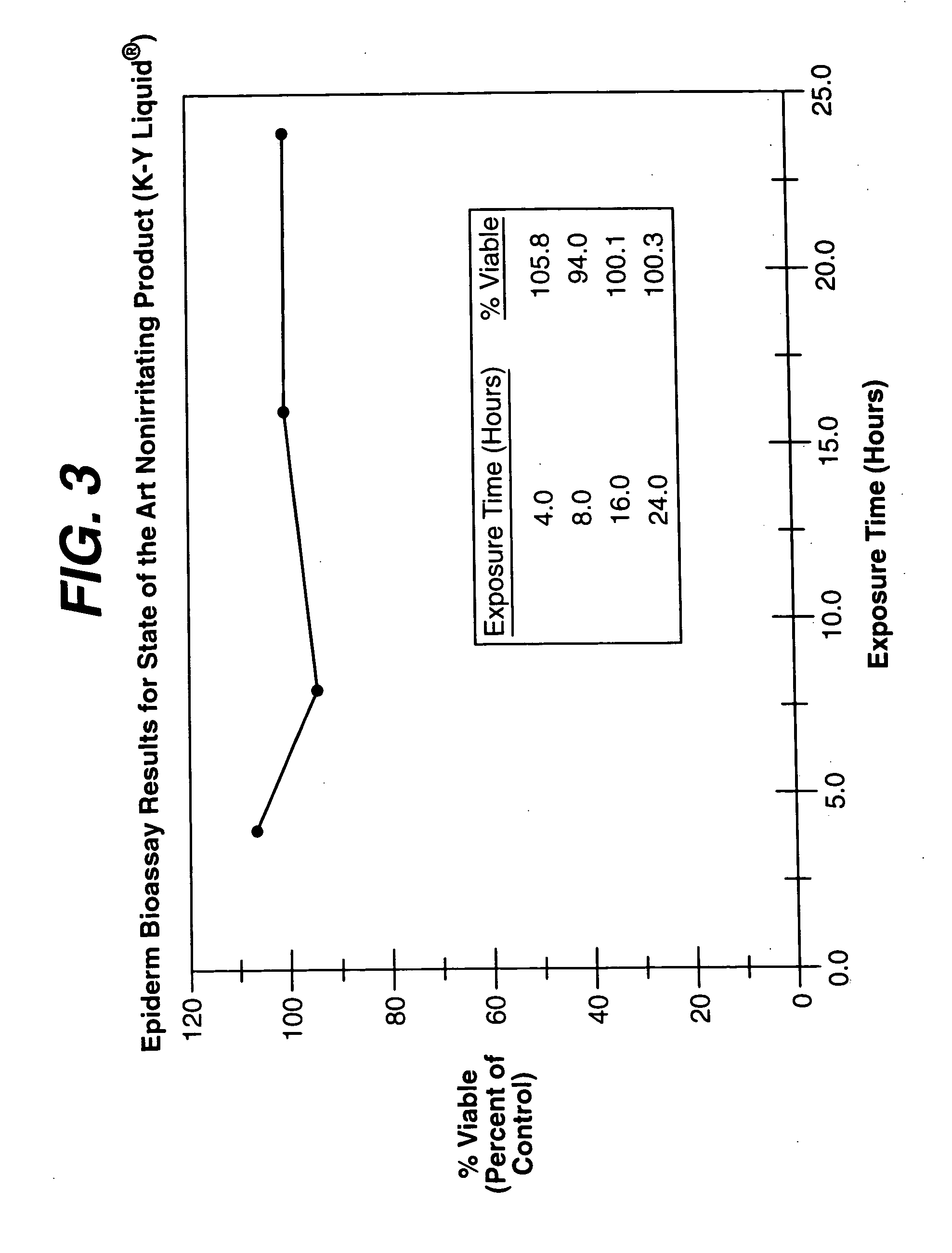Warming and nonirritating lubricant compositions and method of comparing irritation
a technology of lubricant composition and composition, which is applied in the direction of biocide, aerosol delivery, prosthesis, etc., can solve the problems of irritation of the mucosa, discomfort of the user's body, so as to reduce the temperature rise proportionally, and the effect of adversely affecting the heating capacity of the produ
- Summary
- Abstract
- Description
- Claims
- Application Information
AI Technical Summary
Benefits of technology
Problems solved by technology
Method used
Image
Examples
example 1
of the invention (FIG. 1) and Example 2 of the invention (FIG. 2) showed 91.1% and 96.9% viable cells respectively. FIG. 4 shows the results of a warming composition known to the trade. This product uses plant materials like cinnamon, clove, ginger cloves and orange and others for a warming sensation. The results show only 37.6% viable cells after 24 hours of exposure to this product. This indicates that such compositions will be irritating to the skin and mucous membranes. Compositions 1 and 2 of this invention, with 91.1% and 96.9% viable cells respectively, will be practically nonirritating. Positive control (Triton X-100) has only 22.4% viable cells at the 8-hour interval.
example 2
Generation of Warmth
The compositions of this invention are anhydrous and contain one or more polyhydric alcohol. When combined with water, the polyhydric alcohols used in the compositions of this invention generate an increase in temperature that has a soothing effect on the tissues these compositions are applied. In actual use the compositions of the invention interact with the moisture of the vaginal or oral mucosa, thereby increasing the temperature or generating feeling of warmth.
The “Generation of warmth” data summarized in Table 1 below, was generated by mixing 20 ml of each of the ingredients in Composition 1 and Composition 1 of this invention with 20 ml of water. The temperature of the product and that of water were recorded before water was added to the product. After the addition of water the mixture was mixed for two minutes and the actual temperature was recorded. Glycerin, Propylene Glycol and Honey are the ingredients in Composition 1. It is clear from Table 1 tha...
example 3
Effect of Water Content on Generation of Warmth
On contact with moisture or water the heat of solution is responsible for the warming action of the compositions of this invention. There is a concern that accidental contamination with water or prolonged exposure to excessive moisture, the warming capacity of the product may be adversely effected. According to this example, water was added to compositions of this invention varying from about 1% to about 10% as outlined in Table 2 below. The contents were thoroughly mixed and the samples were allowed to stay at room temperature for 24 hour following which the generation of warmth was determined as outlined in the following paragraph. The results show that rise in temperature is proportionately decreased depending on the quantity of water added but there is still an 8.5° F. increase in temperature at about 10% water addition.
The results of this example are set forth in Table 2 below.
TABLE 2Effect Of Water Content On Generation Of W...
PUM
| Property | Measurement | Unit |
|---|---|---|
| Temperature | aaaaa | aaaaa |
| Fraction | aaaaa | aaaaa |
| Fraction | aaaaa | aaaaa |
Abstract
Description
Claims
Application Information
 Login to View More
Login to View More - R&D
- Intellectual Property
- Life Sciences
- Materials
- Tech Scout
- Unparalleled Data Quality
- Higher Quality Content
- 60% Fewer Hallucinations
Browse by: Latest US Patents, China's latest patents, Technical Efficacy Thesaurus, Application Domain, Technology Topic, Popular Technical Reports.
© 2025 PatSnap. All rights reserved.Legal|Privacy policy|Modern Slavery Act Transparency Statement|Sitemap|About US| Contact US: help@patsnap.com



